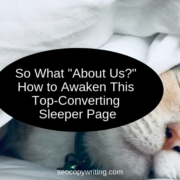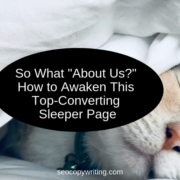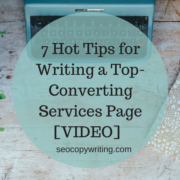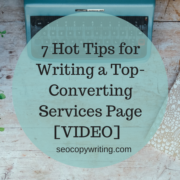The Conversion Dilemma: AIDA in the Internet Age
 A marketer’s job is to reduce, and hopefully remove, any and all barriers to THE SALE.
A marketer’s job is to reduce, and hopefully remove, any and all barriers to THE SALE.
The conversion drives everything we do. Social standing, likability, awareness, fairness, law, order, kittens*, etc . –we care about these things because they potentially impact SALES. Dollars. Greenbacks. Dead Presidents. Moolah.
And while the AIDA (Attention-Interest-Decision-Action) model is about as new as spats and talkies, the cyber-sales era presents unique issues.
Never before have more sensory cues battled for attention, more products and services vied for interest and more factors affected the decisions of consumers.
And never before has the call to action suffered from more inaction – a national stasis rooted in Internet-capable plasma TVs, Snuggies and Cool Ranch Doritos.
The links of AIDA are rusty at best, snapped at worst; it is a web marketer’s challenge to repair them.
Tactics We’ve Outgrown
Times they are a changin’; we must change with them. No longer can we count on:
- Door-to-Door Sales
The only people approaching doors these days are Jehovah’s Witnesses and kids selling auto-renewing Allure subscriptions. Today, we must communicate personality and likability virtually.
- Advantage of Location
With a glut of competition accessible in a .27 second Google search, being physically proximate to your consumers is (generally) not good enough.
- Ignorance
Savvy consumers are accustomed to advertising – this post-modern audience demands interesting and dynamic rationale for purchase.
- Singularity
Multi-tasking killed the radio star. Billboards, cellphones, email, IM, TV, streaming, THIS. Stimuli, stimuli, stimuli… When’s the last time you focused on one thing?
How to Rebuild the AIDA Model
But enough gloom and doom. Guiding a prospective consumer through the steps of AIDA in this climate is difficult, but not impossible. Magic wand time. Do I have your Attention? Good. Let’s proceed.
Attention/Interest
I know you’re there; I just don’t care.
Imagine I walk up and punch you in the face. Do I have your attention? Yes? Would you like to buy this lovely purse filled with diamonds, fat free Cinnabons and peace?
Probably not so much.
While gaining attention is step one – and a necessary step at that – it doesn’t necessarily translate into interest. If you annoy, aggravate and otherwise antagonize your target, attention can have the opposite reaction. Hitler got Poland’s attention, but they certainly weren’t buying what he was selling.
The link between attention and interest is broken when:
The attention is negative –OR–The target becomes interested in the campaign, but not the product it’s promoting.
- Solution
Unless you are SOLELY interested in awareness, avoid campaigns that are entirely reliant on entertainment value. There are simply too many things competing for eyeballs today (YouTube / Tivo / Cats that look like Hitler).
Tether the advertising campaign to your product with social media, optimized copy and a brand personality consistent with the wants and needs of your target market. Internet marketers must establish a direct connection between campaign and product that delivers consumer value.
Interest/Decision
I’m interested in what you’re selling… but not interested enough to decide to buy.
These folks are perhaps best described as fence sitters – consumers that need the cattle prod. Absent using an actual cattle prod (which would be both impractical and illegal), internet marketers need to take the concept virtual.
- Solution
INCENTIVIZE. This is where “deals” and other drivers – flash sales, discounts on shipping, coupons for “liking” the Facebook page, sales aimed at specific groups – can tip the scale. The internet is particularly good at creating a sense of immediacy; use it. Emphasize that NOW is the time to buy and try.
Decision/Action
I’ve decided to buy this product, but…
You’re on the one yard line, but for some reason, you’re not scoring. Your mission: ID that blocker and take him out.
- Solution
Use Google Analytics to identify bounce / exit pages and gather stats on cart abandonment. Isolate and remove major barriers to purchase, such as:
Annoyance
While follow-up is part of any successful sales strategy, MODERATE. Asking too much of your customers (questions, password creation and the like) is a sure-fire way to provoke a hasty exit. It is often difficult to recognize when assertive jumps track into annoying, so monitor interactions. Just because you can’t SEE your target doesn’t mean the feedback loop doesn’t exist.
Expectations
Manage expectations early. If there’s a big pill to swallow (for example, shipping is a zillion dollars), don’t sock customers with it at the very end. If you find shipping fees prove to be a constant transactional impediment, build that cost into the item’s core price. Also, keep in mind the “H” of S&H is regarded as highly suspect by many consumers.
Method of Payment
Make buying online as easy as possible. Don’t expect consumers to hunt down credit cards – offer them options like (Godsend!) Paypal.
Sales and Delivery Models
Evaluate potential stumbling blocks to initial and repeat business. Is auto-renewal scaring off sales? Do deliveries require an in-person signature? Is a slow website inducing customer comas? All of these factors can affect an income statement. A-B tests can answer some of these questions.
Thank you for wading through my webmarketacular. Feel free to disagree (or even agree!) with me in the comments.
*I care about kittens. Fundamentally. Practically exclusively.
 About the Author – Katie Fetting-Schlerf
About the Author – Katie Fetting-Schlerf
Katie Fetting-Schlerf is a copywriter and all around marketing whiz-kid at Portent, an internet marketing company. She would like to impress her employers, so feel free to ‘like’ the crap out of this post. You can find Katie on Twitter @KatieLFetting.







A good article that touches on something I’ve been thinking about a lot lately – what makes copy interesting? You make a good point that it is important that the reader becomes interested in the product or service and not the campaign itself. (An issue I think lots of advertising agencies overlook – there are loads of TV adverts that I do take notice of, but haven’t a clue what they are selling!). Making sure the interest is good interest is also a great point…though I guess you can’t please all the people all of the time.
Something you didn’t mention is that the Internet is slightly different to old school sales in the fact that your visitors are most likely to have searched for you. So they have some need for your business already. I always looked at it as kind of like when you are attracted to someone…if they are making eye contact and smiling, you know half of the battle is already won, so you just need a good opening gambit – web copy is a lot like that, really.
Your employer is impressed! But everyone, keep liking the crap out of this article.
Great point on the search issue, Mr. Straygoat! (Though in my experience, the eye contact and smiling is generally for the person standing directly behind me… So sad.)
And thank you Ian :)